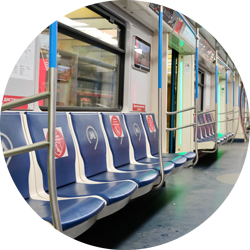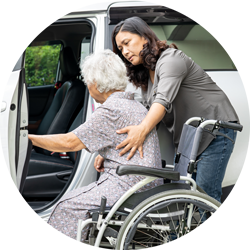Transportation
Helping seniors with transportation is a vital service that ensures older adults can maintain their independence, stay connected with their communities, and access essential services. As people age, they may face physical or cognitive limitations that make it challenging for them to drive or use public transportation safely and efficiently. Providing assistance with transportation for seniors can greatly enhance their quality of life and well-being. Here are some key aspects to consider when describing this important service:

1. Personal Assistance
Seniors often need one-on-one assistance with transportation. This may involve helping them get in and out of vehicles, securing mobility aids like wheelchairs or walkers, and providing a supportive and friendly presence during the journey.

2. Door-to-Door Service
Many seniors require door-to-door transportation services, as they may have difficulty walking long distances or navigating public transit systems. Caregivers or volunteers can pick them up at their homes, assist them with any mobility challenges, and drop them off at their destination.

3. Medical Appointments
One crucial aspect of senior transportation involves getting seniors to and from medical appointments. This is essential for routine check-ups, specialist consultations, and medical procedures. Seniors often need assistance with scheduling appointments, navigating hospital or clinic facilities, and managing any prescribed medications or treatments.

4. Grocery Shopping and Errands
Seniors need to maintain their independence and continue daily activities such as grocery shopping and running errands. Caregivers or volunteers can help with these tasks by providing transportation to stores, helping with shopping, and carrying groceries into the home.

5. Social Activities
Staying socially active is essential for seniors’ mental and emotional well-being. Assistance with transportation allows them to participate in social events, visit friends and family, and engage in hobbies or community activities.

6. Public Transportation Orientation
Seniors who are still able to use public transportation can benefit from orientation and assistance in using buses, subways, and other public transportation options. This can help them become more self-sufficient and mobile.

7. Safety and Comfort
Ensuring that seniors are transported safely and comfortably is paramount. This includes using vehicles with easy entry and exit, proper restraints for mobility aids, and attention to any specific health or medical needs during the journey.

8. Scheduled and On-Demand Services
Transportation services for seniors may be scheduled for routine activities or provided on-demand for more immediate needs. Having flexibility in the service options is important to accommodate various situations.

9. Transportation Providers
Various organizations and individuals may offer senior transportation services, including family members, volunteer groups, nonprofit organizations, and specialized transportation companies. Some areas may have government-funded programs to support senior transportation.

10. Communication and Coordination
Effective communication with seniors and their families is essential to understand their transportation needs and preferences. Coordinating schedules and logistics is also crucial to ensure that seniors receive timely and reliable transportation assistance.
Helping seniors with transportation is a valuable and compassionate service that enables older adults to maintain their independence and remain active members of their communities. It contributes to their overall well-being and can improve their quality of life by ensuring they have access to essential services, healthcare, and social engagement.
